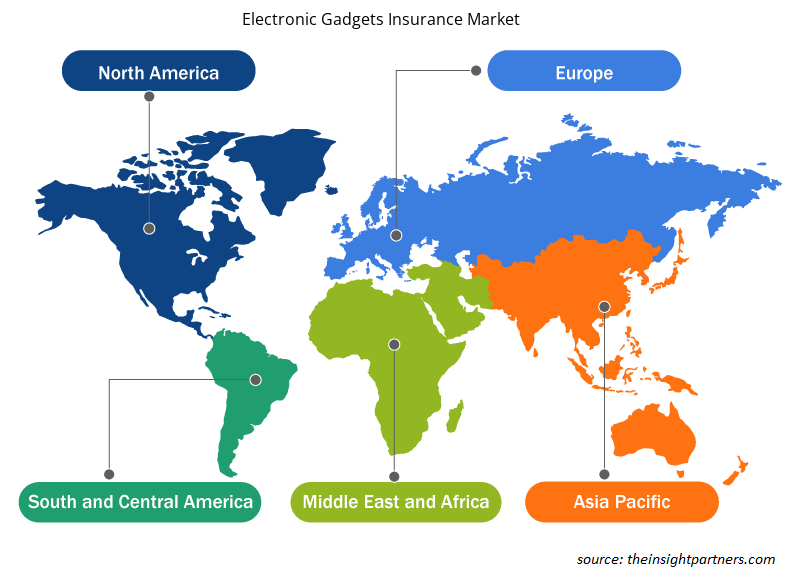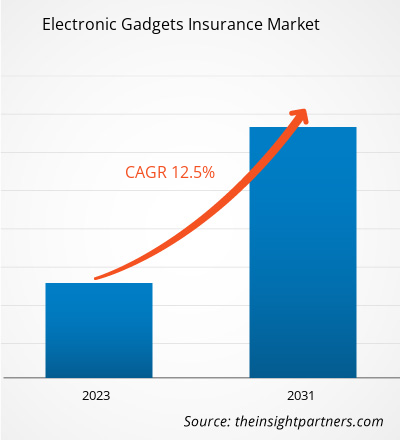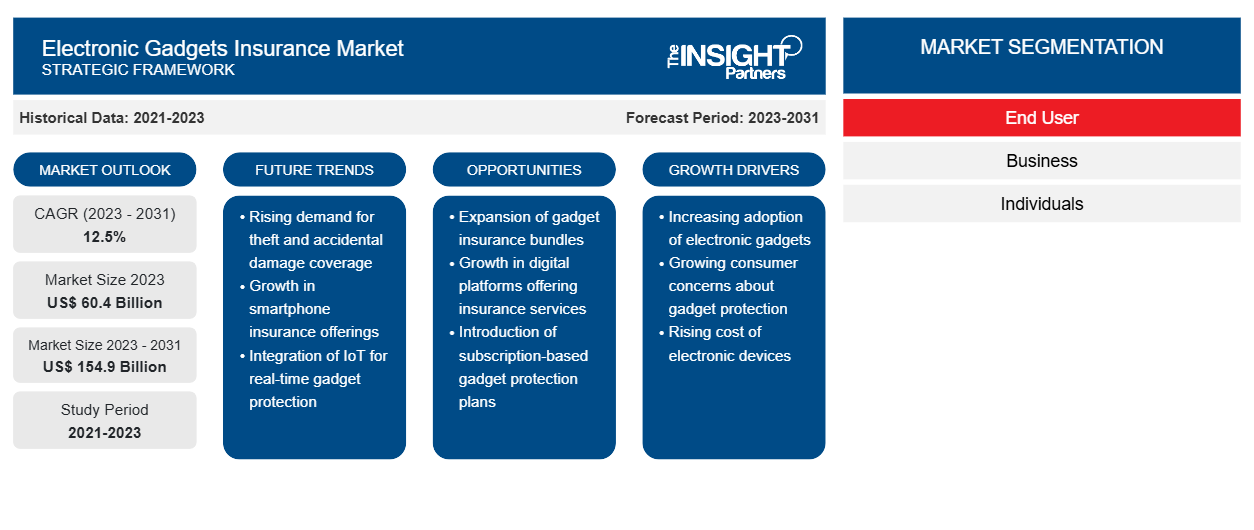電子機器保険市場規模は、2023年の604億米ドルから2025年には100億米ドルに成長すると予想されています。 2031年までに1,549億ドルに達し、2023年から2031年にかけて年平均成長率12.5%で拡大すると予想されています。CAGR of 12.5% from 2023 to 2031. 市場は、偶発的な損傷やウイルス感染の発生の増加の影響を受けています。電子機器保険は、ユーザーに修理サービスを提供します。
電子機器保険
市場分析
電子機器保険市場の成長は、主に偶発的な損傷、携帯電話の盗難、ウイルス感染、デバイスの故障などの事件の増加などの要因によって推進されています。さらに、高品質のスマートフォンの採用の急増も市場の拡大に貢献しています。ガジェットのさまざまな部品の交換コストが高いことも、ガジェット保険市場の成長を促進する上で重要な役割を果たしています。ただし、スマートフォンとタブレットの普及による PC の販売の減少は、市場の成長に対する大きな制約として機能します。逆に、革新的な複数のガジェット保険サービスの需要が急増すると予想されており、新しい電子機器保険市場のトレンドをもたらすことが期待されています。
電子機器保険
業界概要
- ガジェット保険は、小売業者やサービス プロバイダーが販売する電子機器の修理サービスを提供する契約サービスです。通常、不正使用、悪意のある損傷、電子ウォレットによる支払い、盗難に対する追加補償が含まれます。ガジェット保険は、機械的および電気的故障に関連する費用や不便さに対する補償も提供します。さらに、顧客の間で「ガジェットを補償する」という傾向が高まっており、電子機器保険市場の成長に大きく貢献しています。
- ガジェット保険は、小売店、サービス プロバイダー、または独立した保険契約など、さまざまなチャネルを通じて入手できます。住宅所有者保険や賃貸人保険などの既存の保険契約の中には、個人財産のセクションで電子機器をすでに補償しているものがあることに注意してください。ただし、これらの保険契約には、事故による損害は補償されない、または特定のサブ限度額までしか補償されないなどの制限がある場合があります。sublimit.
要件に合わせてレポートをカスタマイズする
このレポートの一部、国レベルの分析、Excelデータパックなど、あらゆるレポートを無料でカスタマイズできます。また、スタートアップや大学向けのお得なオファーや割引もご利用いただけます。
- このレポートの主要な市場動向を入手してください。この無料サンプルには、市場動向から見積もりや予測に至るまでのデータ分析が含まれます。
電子機器保険
市場の推進要因と機会
偶発的な損傷、盗難、機器の故障の増加により電子機器保険が増加
市場の成長
- 電子機器の場合、偶発的な損傷はよくあることです。スマートフォン、タブレット、ノートパソコン、その他の機器が日常生活でますます使用されるようになると、偶発的な損傷の可能性も高まります。機器を落としたり、液体をこぼしたり、あるいはちょっとした事故でも、高額な修理や交換が必要になることがあります。そのため、個人はそのような事故による経済的負担から身を守るために、機器保険を選ぶ傾向が高まっています。
- 盗難は、ガジェット所有者にとってもう一つの大きな懸念事項です。電子機器の価値と人気が高まり続けるにつれて、それらは窃盗犯にとって魅力的なターゲットになります。ガジェットが盗まれるリスクは、公共の場、混雑した場所、さらには自宅や車内でも高くなります。ガジェット保険は盗難に対する補償を提供し、デバイスが盗まれた場合に個人が手ぶらで立ち去らないようにします。
電子機器保険
市場レポートのセグメンテーション分析
- 電子機器保険市場の予測は、補償内容に基づいて、物理的損害、盗難および紛失保護、ウイルスおよびデータ保護、その他に分類されます。
- 物理的損害セグメントは、2023 年に電子機器保険市場で大きなシェアを占めると予想されています。これは、ガジェットの修理および交換コストの増加や、物理的損害補償に関する若者の意識の高まりなど、いくつかの要因に起因すると考えられます。
- 電子機器の修理および交換費用は増加傾向にあります。電子機器が高度化、複雑化するにつれ、損傷した部品の修理または交換費用も増加しています。これには、画面の修理、回路基板の損傷、その他の物理的損傷に関連する費用が含まれます。これらの高額な費用を自分で負担することを避けるために、個人は物理的損傷を補償する電子機器保険を選択しています。この補償は、機器が偶発的に損傷した場合に経済的な保護と安心を提供します。
電子機器保険
地域別市場シェア分析
電子機器保険市場レポートの範囲は、主に北米、ヨーロッパ、アジア太平洋、中東およびアフリカ、南米の5つの地域に分かれています。北米は急速な成長を遂げており、電子機器保険市場で大きなシェアを占めると予想されています。まず、この地域では偶発的な機器の損傷、電話の盗難、ウイルス感染、機器の故障、その他の悪意のある活動が増加しています。日常生活における電子機器への依存が高まるにつれて、そのような事件のリスクも高まっています。さらに、北米にはスマートフォンユーザーが多く、世界のスマートフォンユーザーの約10%がこの地域に居住しており、2020年には3億2000万人のユーザーに達しました。スマートフォンユーザーの数が多いと、特に公共交通機関やフェスティバルなどの混雑した場所では、電話が盗まれるリスクが高くなります。
電子機器保険
電子機器保険市場地域別インサイト
予測期間を通じて電子機器保険市場に影響を与える地域的な傾向と要因は、Insight Partners のアナリストによって徹底的に説明されています。このセクションでは、北米、ヨーロッパ、アジア太平洋、中東、アフリカ、南米、中米にわたる電子機器保険市場のセグメントと地理についても説明します。

- 電子機器保険市場の地域別データを入手
電子機器保険市場レポートの範囲
| レポート属性 | 詳細 |
|---|---|
| 2023年の市場規模 | 604億米ドル |
| 2031年までの市場規模 | 1,549億米ドル |
| 世界のCAGR(2023年~2031年) | 12.5% |
| 履歴データ | 2021-2023 |
| 予測期間 | 2023-2031 |
| 対象セグメント | エンドユーザー別
|
| 対象地域と国 | 北米
|
| 市場リーダーと主要企業プロフィール |
|
電子機器保険市場のプレーヤー密度:ビジネスダイナミクスへの影響を理解する
電子ガジェット保険市場は、消費者の嗜好の変化、技術の進歩、製品の利点に対する認識の高まりなどの要因により、エンドユーザーの需要が高まり、急速に成長しています。需要が高まるにつれて、企業は提供内容を拡大し、消費者のニーズを満たすために革新し、新たなトレンドを活用し、市場の成長をさらに促進しています。
市場プレーヤー密度とは、特定の市場または業界内で活動している企業または会社の分布を指します。これは、特定の市場スペースに、その規模または総市場価値と比較して、どれだけの競合相手 (市場プレーヤー) が存在するかを示します。
電子機器保険市場で事業を展開している主要企業は次のとおりです。
- アップル社
- アシュリオン
- アクサ
- AT&T 社
- バジャジ・アリアンツ損害保険会社
免責事項:上記の企業は、特定の順序でランク付けされていません。

- 電子ガジェット保険市場のトップキープレーヤーの概要を入手
「電子機器保険市場分析」調査は、カバレッジタイプ、デバイスタイプ、エンドユーザー、および地理に基づいて実施されました。カバレッジタイプでは、物理的損傷、盗難および紛失保護、ウイルスおよびデータ保護、その他に分類されています。デバイスタイプに基づいて、ラップトップとPC、携帯電話とタブレット、その他に分かれています。エンドユーザーに基づいて、市場はビジネスと個人に分割されています。地理に基づいて、市場は北米、ヨーロッパ、アジア太平洋、中東およびアフリカ、南米に分割されています。
電子機器保険
市場ニュースと最近の動向
企業は市場で合併や買収などの無機的および有機的な戦略を採用しています。最近の主要な市場動向をいくつか以下に示します。
- 2023年11月、世界最大の上場損害保険会社であるChubbは、Chubb Studioグローバル統合テクノロジーの一環として、新しい開発者ポータルを発表しました。この開発者ポータルは、B2B2Cパートナー企業がChubbのデジタル保険商品と機能にアクセスして評価するプロセスを簡素化することを目的としています。この取り組みにより、Chubbはパートナーエコシステム内でのコラボレーションを強化し、イノベーションを促進することを目指しています。
- 2022年9月、Axa UK Retailは、スマートフォンやタブレットを通じて購入やサービスを利用する顧客を対象としたデジタル専用の保険ブランド、Mojaを導入しました。この導入は、顧客が特定の要件や経済力に応じて保険の補償内容をカスタマイズできる柔軟性を提供することを目的としています。さらに、Mojaは、衛星ナビゲーションシステム、オーディオ機器、子供用カーシートなどの私物に対する補償を含むさまざまな補足オプションを提供し、価値提案を強化しています。
電子機器保険
市場レポートの対象範囲と成果物
市場レポート「電子ガジェット保険市場規模と予測(2021〜2031年)」では、以下の分野をカバーする市場の詳細な分析を提供しています。
- 調査対象範囲に含まれるすべての主要市場セグメントについて、世界、地域、国レベルでの市場規模と予測。
- 推進要因、制約、主要な機会などの市場の動向。
- 今後の主な動向。
- 詳細なPESTおよびSWOT分析
- 主要な市場動向、主要プレーヤー、規制、最近の市場動向を網羅した世界および地域の市場分析。
- 市場集中、ヒートマップ分析、主要プレーヤー、最近の動向を網羅した業界の状況と競争分析。
- 詳細な企業プロフィール。
- 過去2年間の分析、基準年、CAGRによる予測(7年間)
- PEST分析とSWOT分析
- 市場規模価値/数量 - 世界、地域、国
- 業界と競争環境
- Excel データセット
最新レポート
関連レポート
お客様の声
購入理由
- 情報に基づいた意思決定
- 市場動向の理解
- 競合分析
- 顧客インサイト
- 市場予測
- リスク軽減
- 戦略計画
- 投資の正当性
- 新興市場の特定
- マーケティング戦略の強化
- 業務効率の向上
- 規制動向への対応























 無料サンプルを入手 - 電子機器保険市場
無料サンプルを入手 - 電子機器保険市場